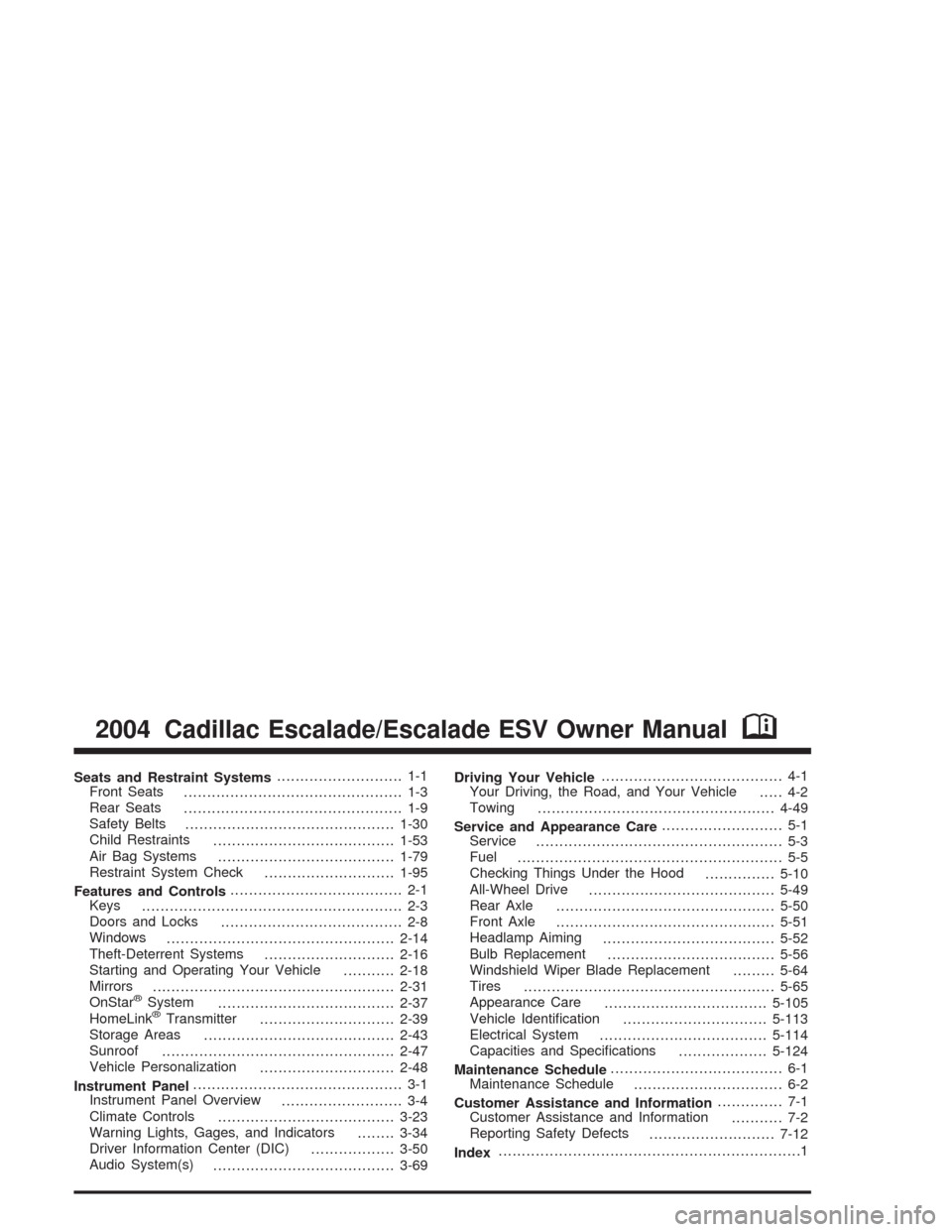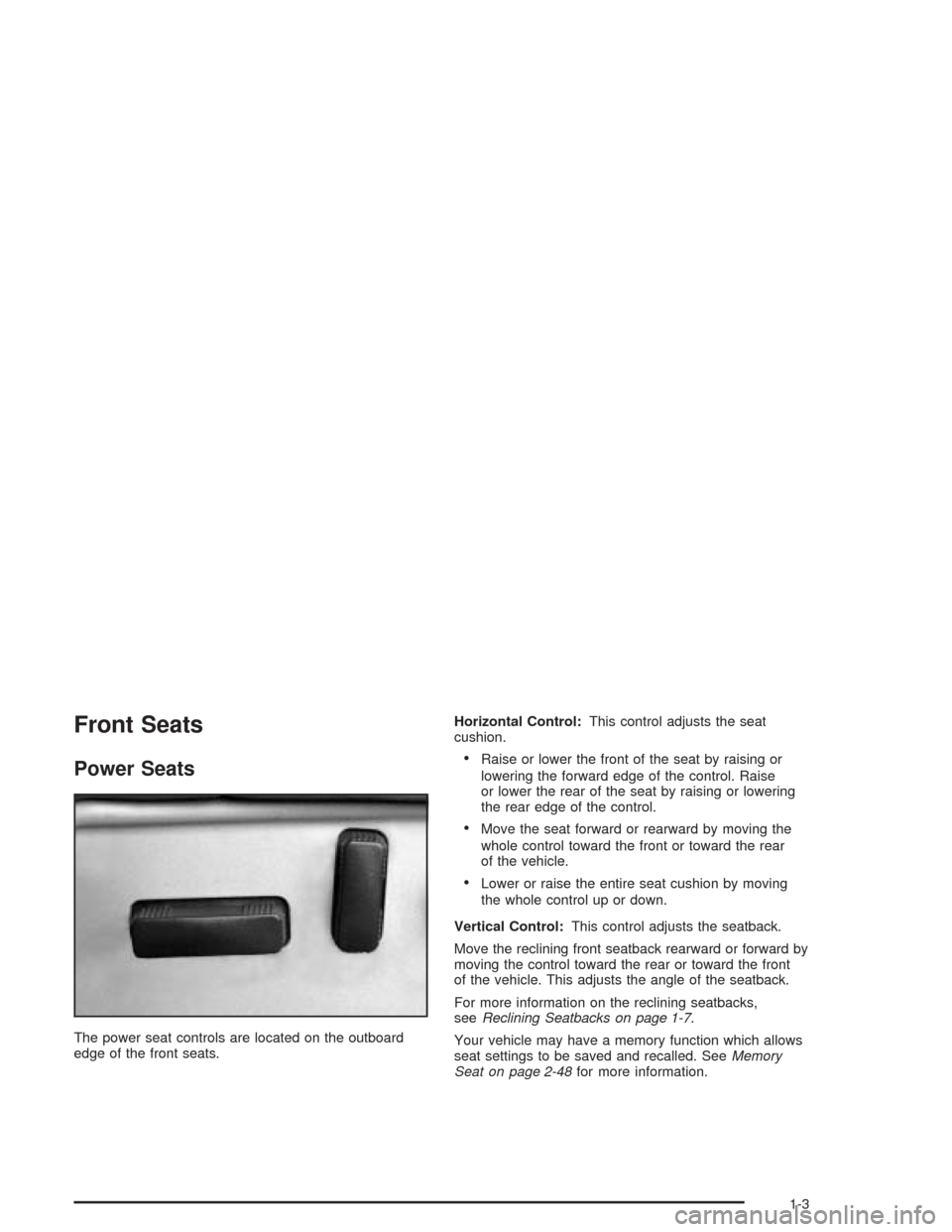tow CADILLAC ESCALADE ESV 2004 2.G Owners Manual
[x] Cancel search | Manufacturer: CADILLAC, Model Year: 2004, Model line: ESCALADE ESV, Model: CADILLAC ESCALADE ESV 2004 2.GPages: 504, PDF Size: 3.27 MB
Page 1 of 504

Seats and Restraint Systems........................... 1-1
Front Seats
............................................... 1-3
Rear Seats
............................................... 1-9
Safety Belts
.............................................1-30
Child Restraints
.......................................1-53
Air Bag Systems
......................................1-79
Restraint System Check
............................1-95
Features and Controls..................................... 2-1
Keys
........................................................ 2-3
Doors and Locks
....................................... 2-8
Windows
.................................................2-14
Theft-Deterrent Systems
............................2-16
Starting and Operating Your Vehicle
...........2-18
Mirrors
....................................................2-31
OnStar
®System
......................................2-37
HomeLink®Transmitter
.............................2-39
Storage Areas
.........................................2-43
Sunroof
..................................................2-47
Vehicle Personalization
.............................2-48
Instrument Panel............................................. 3-1
Instrument Panel Overview
.......................... 3-4
Climate Controls
......................................3-23
Warning Lights, Gages, and Indicators
........3-34
Driver Information Center (DIC)
..................3-50
Audio System(s)
.......................................3-69Driving Your Vehicle....................................... 4-1
Your Driving, the Road, and Your Vehicle
..... 4-2
Towing
...................................................4-49
Service and Appearance Care.......................... 5-1
Service
..................................................... 5-3
Fuel
......................................................... 5-5
Checking Things Under the Hood
...............5-10
All-Wheel Drive
........................................5-49
Rear Axle
...............................................5-50
Front Axle
...............................................5-51
Headlamp Aiming
.....................................5-52
Bulb Replacement
....................................5-56
Windshield Wiper Blade Replacement
.........5-64
Tires
......................................................5-65
Appearance Care
...................................5-105
Vehicle Identi�cation
...............................5-113
Electrical System
....................................5-114
Capacities and Speci�cations
...................5-124
Maintenance Schedule..................................... 6-1
Maintenance Schedule
................................ 6-2
Customer Assistance and Information.............. 7-1
Customer Assistance and Information
........... 7-2
Reporting Safety Defects
...........................7-12
Index.................................................................1
2004 Cadillac Escalade/Escalade ESV Owner ManualM
Page 9 of 504

Front Seats
Power Seats
The power seat controls are located on the outboard
edge of the front seats.Horizontal Control:This control adjusts the seat
cushion.
Raise or lower the front of the seat by raising or
lowering the forward edge of the control. Raise
or lower the rear of the seat by raising or lowering
the rear edge of the control.
Move the seat forward or rearward by moving the
whole control toward the front or toward the rear
of the vehicle.
Lower or raise the entire seat cushion by moving
the whole control up or down.
Vertical Control:This control adjusts the seatback.
Move the reclining front seatback rearward or forward by
moving the control toward the rear or toward the front
of the vehicle. This adjusts the angle of the seatback.
For more information on the reclining seatbacks,
seeReclining Seatbacks on page 1-7.
Your vehicle may have a memory function which allows
seat settings to be saved and recalled. SeeMemory
Seat on page 2-48for more information.
1-3
Page 14 of 504

Head Restraints
Adjust your head restraint so that the top of the restraint
is closest to the top of your head. This position
reduces the chance of a neck injury in a crash.Pull straight up on the head restraint to raise it and
push it down to lower it.
The front head restraints can also be tilted forward in
addition to being slid up or down. To tilt either of
the front head restraints do the following:
Pull the head restraint toward you until you hear a click.
Then let go. The head restraint will stay in this position
unless you pull it forward more until another click is
heard. There are four positions available: initial position,
�rst click, second click, and third click. After the third
position (three clicks) is reached, pulling the head
restraint farther will release it back to the normal upright
position.
The rear head restraints can be slid up or down just as
the front head restraints, but they do not tilt.
1-8
Page 16 of 504

To operate the easy entry seat, do the following:
1. Lift the release lever on the back of the seat, upward.
2. Tilt the seatback toward the front of the vehicle and
the seat will release.
3. Pull (push if you are exiting the third row with no
assistance) the seat forward until it stops.
{CAUTION:
If the seatback is not locked, it could move
forward in a sudden stop or crash. That could
cause injury to the person sitting there. Always
press rearward on the seatback to be sure it is
locked.
{CAUTION:
A safety belt that is improperly routed, not
properly attached, or twisted will not provide
the protection needed in a crash. The person
wearing the belt could be seriously injured.
After raising the rear seatback, always check
to be sure that the safety belts are properly
routed and attached, and are not twisted.
Be sure to return the seat to the passenger position
when �nished. Pull forward and push rearward on the
seat to make sure it is locked in place.
1-10
Page 23 of 504

To return the seatback to an upright position, do the
following:
1. Pull the lever labeled 3 toward you.
2. While still holding the lever 3 toward you, grasp the
top of the seat and pull it toward you slightly.
3. Let go of lever 3 and pull the seat completely down.
4. Push down on the seat �rmly. Try pulling it up to
be sure it is locked into place.5. Pull up on the release
lever labeled 1 and
then pull up on
the seatback or the
assist strap located on
the outboard side of
the seat until the
seatback locks into the
upright position.
1-17
Page 30 of 504

Returning the Seat to an Upright
Position
To return the seatback to the upright position, do the
following:
1. Pull the lever on the
support rod bracket
until it unlatches from
the seat bracket.
2. Place the support rod back into the storage position.
3. Pull the seat toward you and push �rmly down
until the seat latches in the �oor.
4. Try pulling it up to be sure it is locked into place.
5. Pull up on the release lever labeled 1 and then pull
up on the seatback until the seatback locks into the
upright position.
Removing the Bench Seat
To remove the bench seat, do the following:
1. Open the liftgate.
2. Fold the seatback
forward onto the seat
cushion by using
the lever labeled 1.
The seat cannot
be removed unless the
seatback is folded.
1-24
Page 60 of 504

{CAUTION:
Never do this.
Here two children are wearing the same belt.
The belt can not properly spread the impact
forces. In a crash, the two children can be
crushed together and seriously injured. A belt
must be used by only one person at a time.
Q:What if a child is wearing a lap-shoulder belt,
but the child is so small that the shoulder belt
is very close to the child’s face or neck?
A:If the child is sitting in a rear seat outside position,
move the child toward the center of the vehicle. If
the child is sitting in the center position, move
the child toward the safety belt buckle. In either
case, be sure that the shoulder belt still is on
the child’s shoulder, so that in a crash the child’s
upper body would have the restraint that belts
provide. SeeRear Safety Belt Comfort Guides for
Children and Small Adults on page 1-49.
1-54
Page 66 of 504

Child Restraint Systems
An infant car bed (A), a special bed made for use in a
motor vehicle, is an infant restraint system designed
to restrain or position a child on a continuous �at
surface. Make sure that the infant’s head rests toward
the center of the vehicle.A rear-facing infant seat (B) provides restraint with the
seating surface against the back of the infant. The
harness system holds the infant in place and, in a crash,
acts to keep the infant positioned in the restraint.
1-60
Page 92 of 504

Seat Position Sensors
Vehicle’s with dual stage air bags are also equipped
with special sensors which enable the sensing system to
monitor the position of both the driver and passenger
front seats. The seat position sensor provides
information which is used to determine if the air bags
should deploy at a reduced level or at full depoyment.
What Makes an Air Bag In�ate?
In an impact of sufficient severity, the air bag sensing
system detects that the vehicle is in a crash. For both
frontal and side impact air bags, the sensing system
triggers a release of gas from the in�ator, which in�ates
the air bag. The in�ator, the air bag and related hardware
are all part of the air bag modules. Frontal air bag
modules are located inside the steering wheel and
instrument panel. For side impact air bags, the air bag
modules are located in the seatback closest to the
driver’s and/or right front passenger’s door.
How Does an Air Bag Restrain?
In moderate to severe frontal or near frontal collisions,
even belted occupants can contact the steering wheel or
the instrument panel. In moderate to severe side
collisions, even belted occupants can contact the inside
of the vehicle. The air bag supplements the protection
provided by safety belts. Air bags distribute the force of
the impact more evenly over the occupant’s upper
body, stopping the occupant more gradually. But the
frontal air bags would not help you in many types
of collisions, including rollovers, rear impacts, and many
side impacts, primarily because an occupant’s motion
is not toward the air bag. Side impact air bags would not
help you in many types of collisions, including frontal
or near frontal collisions, rollovers, and rear impacts,
primarily because an occupant’s motion is not toward
those air bags. Air bags should never be regarded
as anything more than a supplement to safety belts, and
then only in moderate to severe frontal or near-frontal
collisions for the driver’s and right front passenger’s
frontal air bags, and only in moderate to severe
side collisions for vehicles with a driver’s and right front
passenger’s side impact air bag.
1-86
Page 99 of 504

{CAUTION:
If the air bag readiness light in the instrument
panel cluster ever comes on and stays on, it
means that something may be wrong with the
air bag system. If this ever happens, have the
vehicle serviced promptly, because an
adult-size person sitting in the right front
passenger’s seat may not have the protection
of the frontal air bag. See “Air Bag Readiness
Light” in the Index for more on this, including
important safety information.Aftermarket equipment, such as seat covers, can affect
how well the passenger sensing system operates.
You may want to consider not using seat covers or other
aftermarket equipment if your vehicle has the passenger
sensing system. SeeAdding Equipment to Your Air
Bag-Equipped Vehicle on page 1-94for more
information about modi�cations that can affect how the
system operates.
{CAUTION:
Stowing of articles under the passenger’s seat
or between the passenger’s seat cushion and
seatback may interfere with the proper
operation of the passenger sensing system.
1-93